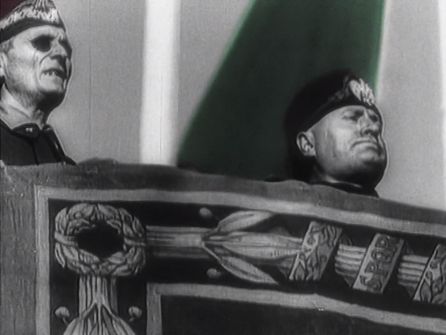A Miguel de Unamuno one of the most hackneyed and manipulated phrases in the recent history of our country is attributed to him. It is not known if he pronounced it that October 12, race day as the right described it, in the auditorium of the University of Salamanca. And there are few certainties about what really happened in those days, the last weeks of the philosopher before he died. Words for the end of the world delves into the hours before death and the days after it. And it sows many questions about Unamuno’s death. Why was there no autopsy? Why do the minutes reflect different times of death? Who was Bartolomé Aragón, the last one who spoke to him before he died? Was Unamuno akin to Falangist ideas or did the regime appropriate it?
This documentary tries to answer all these questions, which will be presented at the Seminci on Sunday, and to which the SER string. Your director, Manuel Menchon, had already approached the figure of Unamuno in The island of the wind, a documentary about his years in exile in the Canary Islands during the dictatorship of Primo de Rivera. For his next project, he wanted to approach a key moment, from the point of view of propaganda, in the Civil War, such as his speech at the university with Carmen Polo present and Millán Astray. It was crucial, because there the manipulation of his figure by the fascists began to take shape and the end of Unamuno was also written.
From all the investigations, the documentary grew to what it finally is: a new turning point about our past and about the culture wars, something very fashionable in Congress. What the director does is mount a classic documentary, with several narrators, the main voice is that of the actress Marian Alvarez, with José Sacristán, that gives voice to the writings of Unamuno, Antonio de la Torre that gives voice to General Mola, and Victor Clavijo the fearsome Millán Astray. There are no talking busts, only one: that of Unamuno’s grandson, who supports the thesis of the film and gives voice to family memories.
Unamuno’s notes before his speech on October 12 / CEDIDA
The rest are archive images, many of them unpublished, such as the burning of books in different Spanish cities, or the image of Millán Astray with Mussolini together. Images of the fascists entering Salamanca or of the dead in the gutters, where most are still lying. The documentary traces the proclamation of the Second Republic until the death of Unamuno in the year 36, in the midst of the war, comparing the propaganda strategy of German Nazism and Italian fascism with that of the Spanish coup plotters.
In that strategy, the figure of Unamuno was key. Dissatisfied with some decisions of the republican governments, such as the repression of Asturias or the burning of convents and churches, he even said “Spain hurts me and the republic hurts me.” Catholic, conservative and angry with the Republicans, like Ortega, he was an easy target for the Falangists. However, the documentary casts doubt on whether Unamuno collaborated or gave in.
For example, the payment of 5000 pesetas, something that appears in Amenábar’s film about the philosopher, As long as the war lasts and that, according to Menchón’s hypothesis, it was not so. Unamuno paid, but he was broke, so it was difficult for it to be a voluntary payment; but rather something like a revolutionary tax. Something that they copied from Nazism and that consisted of making like-minded businessmen pay that amount, which was attributed in the account books to personalities and intellectuals who should be brought closer to the regime, as in this case the author of Fog. This information was disseminated in the foreign press to give the image that all the great men of Spain supported the rebellious side.
 –
–Millán Astray with Mussolini / CEDIDA
Let’s go back to the climax. The death of Unamuno. Franco’s story is what we have believed to this day. The winning story. The one who says that he died, with his shoe burned in the brazier, saying that “Spain will be saved, because it has to be saved!” Were they really Unamuno’s last words? There is only one witness to that phrase and his death. It is Bartolomé Aragón Gómez that, until today, was considered an old student of the writer. Not true, the movie tells us. There is no academic record to prove it, nor has any correspondence between the two been found. Nobody around him knew this man. Aragon was born in Huelva, studied in Pisa and there he soaked up Italian fascism. Back in Spain, he was a man close to Millán Astray and one of those who worked in the propaganda of the Regime.
The documentary presents a series of evidence that questions the official version. For example, the different times of death or the fact that the only witness does not sign the death certificate, or go to the funeral. There is also no autopsy, despite the fact that the cause of death as determined by the doctor is a bulbar hemorrhage and, therefore, should have been carried out. 24 hours are not fulfilled to bury him in Catholic Spain.
It was his own Bartolomé Aragon who wrote the version of death. Published on January 16 and that has been the official voice until today, until the premiere of this documentary, which could turn the investigations around. “They took hold of him to the end,” says his grandson sadly. Not only because they took his corpse from the family home and buried it in a propaganda funeral; but because his entire figure and his legacy have been used, something that still It happens today, to defend some precepts of fascism and the extreme right. That is the great change that it offers Words for the end of the world, to break with the image that Unamuno supported fascism.
The “You will win but you will not convince” has been used ad nauseam. Beware of doing it from now on.
–



Just three comments regarding Mr. Menchon’s documentary – “Palabras para un fin del mundo:”
1. Miguel de Unamuno is defined by his life’s work as a true “Humanist” and defender of the “Rights of Men.” Let his work speak for himself. He is above all one of the greatest thinkers and writer’s the world has ever known, he is well beyond any mundane minutiae.
2. The Novel Commission owes a posthumous apology for not having conceded Don Miguel de Unamuno the Novel Prize, not just in 1935, but considerably earlier. That might be interpreted as an insult not only to him but to whole of humanity. (The same could be said about Federico Garcia Lorca, Miguel Hernandez y Rafael Alberti).
3. If Bartolome Aragon did not directly kill Unamuno, he most likely indirectly did. The record showed he had a well cemented “fascist” ideology and that he brought to Unamuno’s home a “study on Italian fascism.” Why? Obviously to show, discuss with Unamuno and even request from him an introduction or recommendation (as means of propaganda… and, to use once again Don Miguel’s high moral and ethical standing). That could explain the yelling and screams heard prior to his death. And, Aragon’s assertion “I did not kill him…!” That is a statement full of guilt… Who had asked him?
4. The death of Unamuno becomes an 85 year old “cold case.” But, I believe, further investigational course should be pursued. I would recommend to start by ensuring and proving that the person buried in Salamanca, is in reality the body of Don Miguel. That will be easy to know through DNA analysis. If that is the case, I would recommend a toxicology study to determine if there were any toxic substances in his body. The poisoning of Don Miguel might had began October 13th., 1936.
Thank you.